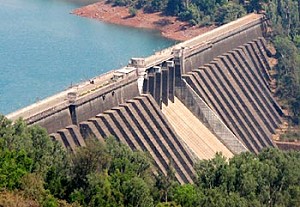Case Study
Research work on the Koyna Dam, India.
- Research work to assist with
long term development of a concrete cracking model
 The
103m high mass concrete Koyna Dam is one of the largest dams in
western Maharashtra, India. Located
in Koyna Nagar, the dam supplies water as well as cheap hydroelectric power to neighbouring areas.
It was constructed in 1963 as one of four dams built as part of the
Koyna project. It has the largest catchment area of all the dams in
the region, forming the Shivajisagar Lake with a length of 50km. In
1967 the dam
was subjected to a magnitude 6.5 earthquake. Accelerometers on the site recorded the time
histories of the event and a later survey showed that cracking had occurred in parts of
the dam. The
103m high mass concrete Koyna Dam is one of the largest dams in
western Maharashtra, India. Located
in Koyna Nagar, the dam supplies water as well as cheap hydroelectric power to neighbouring areas.
It was constructed in 1963 as one of four dams built as part of the
Koyna project. It has the largest catchment area of all the dams in
the region, forming the Shivajisagar Lake with a length of 50km. In
1967 the dam
was subjected to a magnitude 6.5 earthquake. Accelerometers on the site recorded the time
histories of the event and a later survey showed that cracking had occurred in parts of
the dam.
Due to the availability of field data the
Koyna Dam has been the subject of a number of
studies since the seismic event. One, of many studies carried out by
the University of Wales in Cardiff, UK, on the dam used LUSAS Civil & Structural to investigate
the dam's response to changes
in numerical concrete cracking models.
Study aims
The aim of the study was to derive a concrete cracking
model to allow for dynamic cyclic loadings and produce results that closely matched those
of the experimental data. LUSAS was ideal for this because it contains a material model
interface which allows users to develop and research constitutive models for their own
use.
During a seismic event a variety of factors can affect
the predicted response of a dam. Of particular interest is the unloading curve because
when cracks open and close it is well established that the crack stress-strain curve does
not return to zero but to some finite tensile strain indicating that particles have
'wedged' in the open crack.
Using the derived concrete
model, three analyses were undertaken with the same finite element mesh, time step, and
material data. The only difference between the analyses being the shape of the softening
and unloading curves. Bilinear softening assuming no wedged particles, and exponential
softening both with and without wedged particles were investigated. For each analysis,
gravity and hydrostatic loads were applied to the structure and a dynamic analysis was run
applying the combined vertical and horizontal ground motions.
The concrete model with exponential softening and wedged
particles gave the lowest response overall both in terms of response spectra and peak
accelerations. For cyclic dynamic applications it appears to be important to incorporate
both a realistic softening curve and crack wedging behaviour into a numerical concrete
model. Work on this study is continuing to see if other parameters also have a strong
influence on dynamic structural response.
|